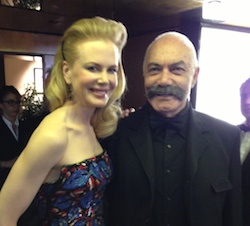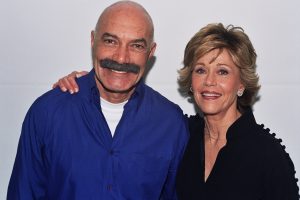




It may sound strange, but, despite its harsh subject matter Born Into Brothels may be too pleasing and life affirming for its own good.
An inspiring look at the transformative journey of some extraordinary children in Calcutta’s red light district, the documentary won the 2004 Audience Awards at the Sundance Film Fest.
Produced and directed by New York based filmmakers Zana Briski and Ross Kauffman, the film is released by the entrepreneurial ThinkFilm, in association with HBO/Cinemax Documentary Films. Born into Brothels opened in New York December 8, to qualify for Academy considerations, and is now beginning a national roll out.
A tribute to the resiliency of childhood and the restorative power of art, Born Into Brothels is a portrait of several children who live in Calcutta’s red-light district, where their mothers work as prostitutes. Zana Briski, a photographer, gave each of the youngsters a camera and taught them how to take pictures, motivating them to look at their world with new, fresh eyes. Together with Kauffman, Briski captures the magical way in which beauty can be found in the most unlikely of places and how a bright, promising future becomes a possibility for children who previously had no future at all.
Touching yet devoid of sentimentality, Born Into Brothels defies the more conventional mode of touristy snapshot of this global underbelly. Briski spent years with these children and became a part of their lives. Their photographs are prisms into their souls, and a true testimony to the power of the indelible creative spirit. Born Into Brothels is the kind of documentary that its very making changes and even transforms both directors and their subjects, in expected and unexpected ways.
A photojournalist documenting the brothels’ prostitutes, Briski became enthralled with their children, and decided to give them cameras and basic lessons of how to use them. The children’s photographs are variable, reflecting the subjective talents of those who take them. But they also point to a larger, more instructive and poignant issue: Art as a liberating and empowering force. As soon as the children start snapping photos, they discover how to express themselves. Understandably, the filmmakers stress (perhaps too much) the positive aspects of art’s magical power, how it can transform and transcend hard realities by bringing light and life to the most challenging existence.
“When I arrived in Calcutta’s red light district,” Briski recalls, “I had no intention of teaching the children photography. I went there to do my work, to photograph the women’s lives. It was only after spending some time with the children that I felt I wanted to do something for them.” Hence, she decided to buy 20 point-and-shoot cameras, and began doing the only thing she knew, teaching them the basics of photography.” They began working with the cameras, learning every aspect of the process, from composition to developing. Ultimately, some of the kids were able to take ownership and pride in their new “work.”
As soon as Kauffman saw Briski’s raw footage, he wanted to be a part of the unusually creative process. For him, just witnessing the kids’ transformation was remarkable, as Briski helped them to learn “how to dream outside of the district.” During the learning process, the kids became exposed to the world existing beyond the sleazy district. They take pictures of the streets, the zoo, the beach, and they return with joyous pictures of the rolling tide.
All of this leads to social activism of the best kind. Inspired by the talent on display, and concerned for her disciples’ future, Briski embarks on a monumental taskgetting the kids out of the brothels. Many of the kids do not attend school regularly, and their options are limited to state-run institutions. Finding boarding schools that are willing to take in the children becomes a daunting task, but undeterred, Briski’s efforts go further.
In its most interesting parts, the film shows Briski navigating India’s red-tape bureaucracy in search of birth certificates, ration cards, and other required documents. Making things worse, before the schools will accept them, the kids must take HIV tests, which Briski also arranges. Meanwhile, exhibits of the children’s photos are arranged, first in New York, then in Calcutta, to raise money for their education. The kids’ delight and pride at seeing their work on public display makes for one of the docu’s most powerful and touching sequences
Helping the kids to transcend their world proves a complicated task. For example, Avijit is selected to travel to Amsterdam to take part in a youth photo conference, but is distracted by the loss of his mother. Suchitra is in danger of being forced by a family member “onto the line,” i.e. into prostitution. Tapasi worries about the fate of her infant sister. And all the children are confronted by the brothel’s chaos and danger: angry customers, alcohol and drug abuse, thievery, and murder. The film’s last reel reveals where each child is now, and the results are decidedly mixed: Avijit, Kochi, and Tapasi are in boarding schools, but many of the others have not gone, despite Briski’s efforts.
Inspired by her work in Calcutta’s red light district, Briski has started a foundation called “Kids With Cameras,” to continue support of the kids. The foundation also aims at sending other professionals to teach kids photography and to pursue their own work.
Born Into Brothers calls for a follow-up, in the manner of Michael Apted’s seminal documentary about British kids, “7 Up-42 Up.” It would be fascinating to observe the careers and fates of these children in time intervals of 5 to 7 years.
Photographers’ Bios
Avijit, 12: Avijit is a talented artist who has won many competitions for his paintings. Charismatic and restlessly creative, his images were among the most compelling of the workshop. Avijit was invited by the World Press Photo Foundation in Amsterdam to be part of their 2002 Children’s Jury. Avijit now lives at the Future Hope Home For Boys and attends one of the best schools in Calcutta.
Gour, 13: The sensitive and thoughtful Gour dislikes his environment and wants to use photography to change it. He photographs his friends playing cricket, his pet rabbits, and his best friend Puja. Gour plans to go to university with the support of Kids With Cameras.
Puja, 11: Puja photographs in her room, which she shares with her mother, great-grandmother, and pet parrots. A tomboy, she and Gour are best friends.
Kochi, 10: Shy, Kochi uses the camera to escape her surroundings, taking pictures of her family, animals, gardens, and parks. She says she prefers taking photos to editing. She now lives at the Sabera Foundation Home For Girls and is learning English and computer skills.
Manik, 10: Manik lives in a small room with his sister, Shanti, and loves kites. Though quiet, he is a daring photographer who likes to experiment with composition.
Shanti, 11: Shanti, who lives with her brother Manik and their mother, likes to photograph her family. Favoring video, Shanti filmed one of the docu’s classroom scenes.
Suchitra, 14: A gifted girl, she takes photographs of daily life on her rooftop. Suchitra’s photo of her sister’s friend was chosen as the cover of the 2003 Amnesty International.
Tapasi, 11: Tapasi wants to be a teacher and dreams of being able to take her younger brother and sister away from the red light district. She photographs her life’s hard reality, using the camera to tell her story. Tapasi now lives in the Sanlaap Home For Girls.










